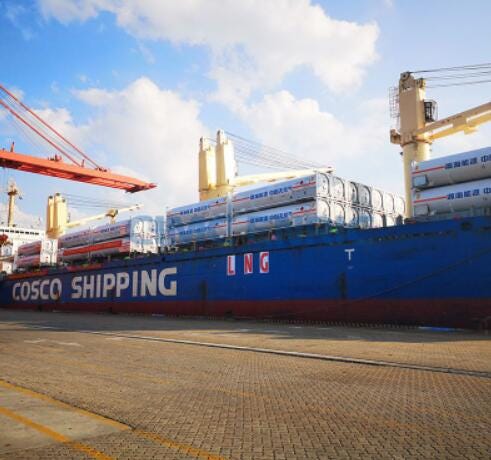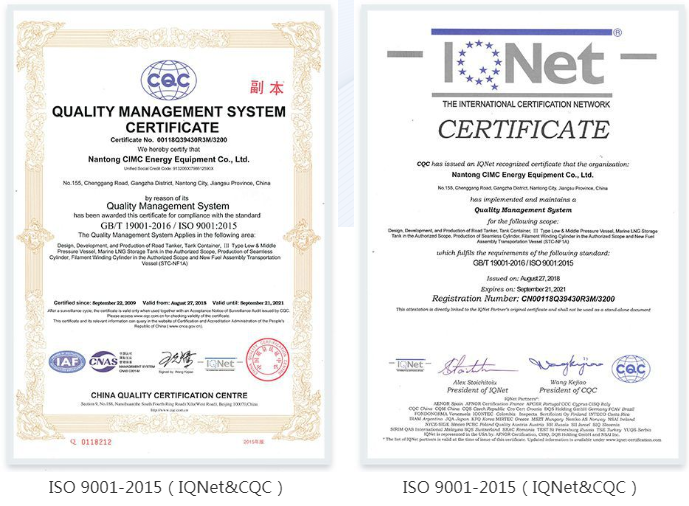Know LNG iso container the features, types and dimensions from LNG storage tanks manufacturer-Cimc Enric.

The LNG iso container is designed for transporting gases. Find the right LNG iso container by taking a comprehensive look at its features and specifications.
As the demand for international trade grows, so does the need for quality and reliable transport. To transport LNG on a global scale, LNG iso containers meet this need with a variety of customizable features.
In many countries, LNG iso tank containers are used to optimize the energy supply chain and to obtain liquefied natural gas (LNG) for use in cities and remote areas. LNG iso tank containers offer an effective solution to the problem of LNG supply.
Having said that, the 40 ft iso tank container and the ISO VAC 40 LNG container are different names for the shipping industry, but they are the same LNG iso tank container.
Now that we have that cleared up, do you want to buy an lng iso tank container straight away, then click on the banner below to find the LNG iso tank container at the best price in your preferred location.
If you would like to find out more about these special tanks, please read on to get a full understanding of LNG iso tank containers and their features.
The LNG iso container is a type of chemical storage tank, Lng is the full name of Liquefied Natural Gas, which translates as liquefied natural gas, hence the name LNG iso container, which is used specifically for storing LNG.
Generally, iso tank containers are LNG tank containers manufactured according to ISO standards (International Organisation for Standardisation) and are used for the transport of various liquids and gases. More specifically, LNG iso containers are designed for the efficient bulk transport of liquefied natural gas (LNG).
These iso tanks are made of stainless steel. In addition, they have multi-layer vacuum-insulated pressure tanks, supported by double-walled transport tanks. Thus allowing them to hold LNG at temperatures of -162 °C (-260 °F). the LNG ISO tank containers have a maximum pressure level of 0.690 MPa.
The LNG iso tank container has two containers — an inner tank with LNG and an outer tank with insulating material. Fully sealed tanks are the most common and their size varies depending on their purpose. Transporting LNG in ISO tanks is an innovative and effective alternative to traditional natural gas distribution.
lng iso containers
The LNG iso tank container is an intermodal container for the transport of liquids, gases, and powders. It is built to ISO standards, making it suitable for different modes of transport.
The LNG iso container usually consists of 4 to 6 tanks arranged down the center. The vessel has a double-hull design, as two separate ballast tanks, cofferdams and voids surround the compartment.
LNG or Liquefied Natural Gas is the conversion of natural gas (mainly a mixture of methane CH 4 and some ethane C 2 H 6) into liquid form for storage or transport without the use of pressurised vessels or storage.LNG is an odorless, colorless, non-toxic, and non-corrosive gas.
The market is full of manufacturers offering LNG iso tank containers at standard prices. Cimc Enric is a Chinese LNG storage tanks manufacturer and can help you find the right LNG ISO tank container for your requirements.

Now that we have an idea of what LNG iso tanks can transport, here is a quick summary of what is happening in the LNG iso tank market.
The global LNG iso tank container market is estimated to be US$159.1 million by 2021 and is expected to reach US$264 million by 2028.
The key players in the LNG iso tank container market are China International Marine Containers Limited, Nantong Tank Container Company Limited, CXIC Group Containers Limited and Satsuma Containers among others.
In 2021, Europe is the largest region in the LNG iso tank container market, with North America in second place.
To find out more about the latest LNG iso tank market trends, please contact us.
There are various types of iso tank containers on the market, each with its own purpose. So how do you know which one best suits your needs?
Not to worry! Because here is an overview of the common types of iso tanks and the types of goods they are designed to carry.
Food grade iso tanks
These tanks are suitable for transporting temperature-sensitive goods, such as milk. It is made of stainless steel with mineral wool insulation. As a result, the excellent insulation keeps the temperature in for longer.
Sizes: 20ft, 40ft, 45ft
Cargo type: Ideal for transporting/storing food such as beer, milk and hot chocolate.
Silo LNG iso tanks
Made of high-grade steel, silo tanks are renowned for transporting a wide range of grains and powders. From corn and flour to cement, these are your go-to tanks. They are also coated with a UV resistant outer layer to protect the cargo from harsh weather conditions.
Size: 20ft, 40ft, 45ft
Cargo type: These are used for transporting powders or grains such as wheat, oats, and flour.
Swap body iso tanks
Swap body tanks are designed for the transport of hazardous and non-hazardous as well as food-grade bulk liquid cargoes. These tanks allow the transport of larger capacities of up to 35,000 litres. In addition, it can maintain a maximum cargo temperature of +130°C.
Size: 20ft, 23ft, 24ft
Cargo type: An excellent choice when you need more storage space for chemicals.
Reefer lng iso tanks
Sizes: 20ft, 40ft, 45ft
Cargo type: ideal for transporting temperature-sensitive liquids, powders, and gases.
Gas lng iso tanks
Sizes: 20ft, 40ft, 45ft
Cargo types: specifically designed for the transport of industrial, medical, and natural gases. For example LPG and helium-oxygen mixtures.
Multi-compartment iso tanks
Sizes: 20ft, 40ft
Cargo types: great if you want to transport all types of liquids, powders, and gases at the same time.
LNG ISO tanks
With an operating pressure range of 100 psi to 10 Bar, these tanks are ideal for the safe transport of LNG. the LNG tanks also feature high vacuum insulation, a 9-unit high stacking capacity, a full range of decals, and a variety of piping options. All these features provide maximum versatility for end users and operators.
Sizes: 20ft, 40ft, 45ft
Cargo type: for transporting liquefied natural gas (LNG) such as methane and ethane.
Have these ISO tanks caught your interest? Then go to Cimcenric to find your ideal ISO tanks at a price you like.
So far, we know that the LNG iso tank container is the most efficient container for transporting liquefied natural gas. There are 2 types of LNG iso tank containers commonly used in the shipping industry. These are the cryogenic LNG tanks and the standard 20ft and 40ft LNG ISO containers. To best serve their purpose, each type and size has its own unique specifications.
Let’s take a closer look at each of their specifications and indicators.
20ft LNG iso tank container
LNG can be transported over longer distances using cryogenic ISO tank containers. This allows for a more cost-effective supply of fuel to end users far from the LNG supply source. A 20ft cryogenic LNG ISO container provides a storage capacity of 22,000 liters at a working pressure of 17 BARG.
Container size (L x W x H/mm): 6058 x 2438 x 2591
Filling capacity: 22,000 liters
Design temperature: 55
40ft LNG iso tank container
Two 40ft LNG ISO containers can be of different sizes and can be used for different purposes. For example, a 40ft cryogenic LNG ISO container can provide an extraordinary capacity of 45,000 liters with a total payload of up to 36,000 kg. 40ft LNG ISO standard containers are available with a working pressure range of 10 BARG to 22 BARG, with or without pumping options.
Container size (L x W x H/mm): 12,460 x 2,500 x 3,980
Loading capacity: 25,000 litres
Design temperature: 55
20ft standard cryogenic LNG iso tank container
Container size (L x W x H/mm): 6058 x 2438 x 2591
Loading capacity: 20,200 litres
Design temperature: 55

The LNG iso tank container must be handled with extreme care as LNG is highly flammable. The following are some key safety tips to consider when transporting LNG.
The initial filling is usually carried out on a cryogenic tank that has been reactivated after the contents of an ambient cryogenic tank contain a period of stored cryogenic liquid.
Before the initial filling, the liquid level meter and pressure gauge should be checked and calibrated, check whether the various valves are in the correct state of opening and closing, whether the pipeline is open to open the pressure gauge valve, according to the liquid level meter operating procedures to make the liquid level meter in operating condition
When the cryogenic storage tank is used for high purity cryogenic liquid, it should be blown out of the replacement process. The method is: using 70℃~80℃ dry oil-free air or nitrogen, heating blowing out the contents, blowing out time should be not less than 8 hours, then use the product gas for a replacement about lighter than air nitrogen, should be imported from the venting valve, from the bottom liquid import and export valve discharge, about heavier than air oxygen or gas, should be imported from the bottom liquid import and export valve, from the venting valve discharge, when the cryogenic storage tank pressure reaches 0.1 -0.2MPa, discharge the replaced gas, so repeated several times, and the purity of the discharged gas testing, satisfactory before stopping the replacement of each valve pipeline also apply the product gas blowing, and satisfied with the purity requirements after the replacement of positive pressure sealing 4, filling storage of general cryogenic liquid, without the above blowing replacement process
The first filling, advocates the use of atmospheric pressure filling, that is, before filling open the contents of the emptying valve, to be closed only after all the filling is completed, filling process in the contents of the vessel at atmospheric pressure or low pressure, the operation is convenient about filling rare or valuable cryogenic liquids, can first cryogenic storage tank cylinder with liquid nitrogen cooling, with low-temperature product gas replacement to the specified purity, and then filled with cryogenic liquids.
When handling natural gas, the gas may seep into clothing, so avoid smoking near the tank, especially when filling and discharging. In the event of a leak, remove all sources of ignition and disconnect the gas supply. In addition, shut off leaks and electrical installations and maintain adequate ventilation. Avoid sealing containers containing liquefied gases. If kept sealed, evaporation of the gas may cause a pressure rise. This increase in pressure can lead to personal injury and damage to equipment.
Want to learn more about common safety issues and their solutions for transporting LNG ISO tanks? Then read this study for a more in-depth understanding.
You have found LNG iso tank containers just what you are looking for. But now, how do you find them? Sourcing so tank containers, let alone LNG ISO tanks, can be a tedious and stressful process due to the scarcity on the market. But fortunately, we have the LNG iso tank container solution for you.
If you want to buy or even sell standard and special lng iso tank containers, Cimcenric is at your disposal!
Previous: Building Integrated Photovoltaics: Advantages, Disadvantages and Costs of BIPV
Next: OS-M72-300W~350W Monocrystalline Photovoltaic Module monocrystalline solar panel supplier
Copyright:@2020-2021
Comments Please sign in or sign up to post.
0
0 of 500 characters used